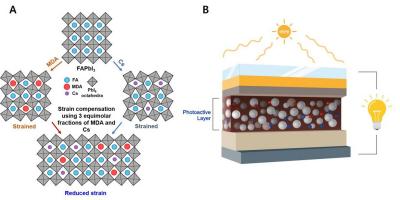Researchers from South Korea's Ulsan National Institute of Science and Technology (UNIST) have reported a conversion efficiency of 25.17% in a perovskite solar cell, achieved by minimizing the deformation for the microstructure of photoactive layers in the device.
 The inner structure of the newly-developed photoactive layer, as well as the working principle of the perovskite cell. Image: Unist
The inner structure of the newly-developed photoactive layer, as well as the working principle of the perovskite cell. Image: Unist
The team explained that the microstructure of these layers, which generate an electric charge and send it to electrodes, can be deformed - which affects the efficiency of the charge transfer itself. 'This is because the extracted electric charges disappear when defects are formed,' they explained.
The Korean team also stated that the cell maintained over 80% of its initial efficiency after 1,300 hours in the dark at 85 degrees Celsius.

